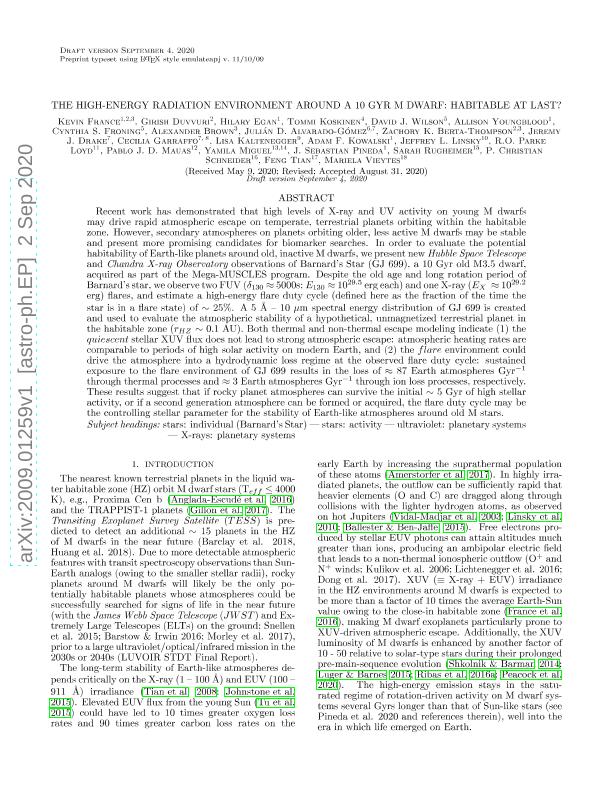Mostrar el registro sencillo del ítem
dc.contributor.author
France, Kevin
dc.contributor.author
Duvvuri, Girish
dc.contributor.author
Egan, Hilary
dc.contributor.author
Koskinen, Tommi
dc.contributor.author
Wilson, David J.
dc.contributor.author
Youngblood, Allison
dc.contributor.author
Froning, Cynthia S.
dc.contributor.author
Brown, Alexander
dc.contributor.author
Alvarado Gómez, Julián D.
dc.contributor.author
Berta Thompson, Zachory K.
dc.contributor.author
Drake, Jeremy

dc.contributor.author
Garraffo, Cecilia

dc.contributor.author
Kaltenegger, Lisa
dc.contributor.author
Kowalski, Adam F.
dc.contributor.author
Linsky, Jeffrey L.
dc.contributor.author
Parke Loyd, R. O.
dc.contributor.author
Mauas, Pablo Jacobo David

dc.contributor.author
Miguel, Yamila

dc.contributor.author
Pineda, J. Sebastian
dc.contributor.author
Rugheimer, Sarah
dc.contributor.author
Schneider, P. Christian
dc.contributor.author
Tian, Feng
dc.contributor.author
Vieytes, Mariela Cristina

dc.date.available
2023-01-02T15:59:27Z
dc.date.issued
2020-10
dc.identifier.citation
France, Kevin; Duvvuri, Girish; Egan, Hilary; Koskinen, Tommi; Wilson, David J.; et al.; The High-energy Radiation Environment around a 10 Gyr M Dwarf: Habitable at Last?; IOP Publishing; Astronomical Journal; 160; 5; 10-2020; 1-15
dc.identifier.issn
0004-6256
dc.identifier.uri
http://hdl.handle.net/11336/182911
dc.description.abstract
Recent work has demonstrated that high levels of X-ray and UV activity on young M dwarfs may drive rapid atmospheric escape on temperate, terrestrial planets orbiting within the habitable zone. However, secondary atmospheres on planets orbiting older, less active M dwarfs may be stable and present more promising candidates for biomarker searches. In order to evaluate the potential habitability of Earth-like planets around old, inactive M dwarfs, we present new Hubble Space Telescope and Chandra X-ray Observatory observations of Barnard's Star (GJ 699), a 10 Gyr old M3.5 dwarf, acquired as part of the Mega-MUSCLES program. Despite the old age and long rotation period of Barnard's Star, we observe two FUV (δ 130 ≈ 5000 s; E 130 ≈ 1029.5 erg each) and one X-ray (E X ≈ 1029.2 erg) flares, and we estimate a high-energy flare duty cycle (defined here as the fraction of the time the star is in a flare state) of ∼25%. A publicly available 5 Å to 10 μm spectral energy distribution of GJ 699 is created and used to evaluate the atmospheric stability of a hypothetical, unmagnetized terrestrial planet in the habitable zone (r HZ ∼ 0.1 au). Both thermal and nonthermal escape modeling indicate (1) the quiescent stellar XUV flux does not lead to strong atmospheric escape: atmospheric heating rates are comparable to periods of high solar activity on modern Earth, and (2) the flare environment could drive the atmosphere into a hydrodynamic loss regime at the observed flare duty cycle: sustained exposure to the flare environment of GJ 699 results in the loss of ≈87 Earth atmospheres Gyr-1 through thermal processes and ≈3 Earth atmospheres Gyr-1 through ion loss processes. These results suggest that if rocky planet atmospheres can survive the initial ∼5 Gyr of high stellar activity, or if a second-generation atmosphere can be formed or acquired, the flare duty cycle may be the controlling stellar parameter for the stability of Earth-like atmospheres around old M stars.
dc.format
application/pdf
dc.language.iso
eng
dc.publisher
IOP Publishing

dc.rights
info:eu-repo/semantics/openAccess
dc.rights.uri
https://creativecommons.org/licenses/by-nc-sa/2.5/ar/
dc.subject
Actividad Estelar
dc.subject
Solar extreme ultraviolet emission
dc.subject.classification
Astronomía

dc.subject.classification
Ciencias Físicas

dc.subject.classification
CIENCIAS NATURALES Y EXACTAS

dc.title
The High-energy Radiation Environment around a 10 Gyr M Dwarf: Habitable at Last?
dc.type
info:eu-repo/semantics/article
dc.type
info:ar-repo/semantics/artículo
dc.type
info:eu-repo/semantics/publishedVersion
dc.date.updated
2021-08-27T20:51:09Z
dc.journal.volume
160
dc.journal.number
5
dc.journal.pagination
1-15
dc.journal.pais
Reino Unido

dc.journal.ciudad
Londres
dc.description.fil
Fil: France, Kevin. State University of Colorado at Boulder; Estados Unidos
dc.description.fil
Fil: Duvvuri, Girish. State University of Colorado at Boulder; Estados Unidos
dc.description.fil
Fil: Egan, Hilary. State University of Colorado at Boulder; Estados Unidos
dc.description.fil
Fil: Koskinen, Tommi. State University of Colorado at Boulder; Estados Unidos
dc.description.fil
Fil: Wilson, David J.. State University of Colorado at Boulder; Estados Unidos
dc.description.fil
Fil: Youngblood, Allison. State University of Colorado at Boulder; Estados Unidos
dc.description.fil
Fil: Froning, Cynthia S.. State University of Colorado at Boulder; Estados Unidos
dc.description.fil
Fil: Brown, Alexander. State University of Colorado at Boulder; Estados Unidos
dc.description.fil
Fil: Alvarado Gómez, Julián D.. State University of Colorado at Boulder; Estados Unidos
dc.description.fil
Fil: Berta Thompson, Zachory K.. State University of Colorado at Boulder; Estados Unidos
dc.description.fil
Fil: Drake, Jeremy. State University of Colorado at Boulder; Estados Unidos
dc.description.fil
Fil: Garraffo, Cecilia. State University of Colorado at Boulder; Estados Unidos. Consejo Nacional de Investigaciónes Científicas y Técnicas. Oficina de Coordinación Administrativa Ciudad Universitaria. Instituto de Astronomía y Física del Espacio. - Universidad de Buenos Aires. Facultad de Ciencias Exactas y Naturales. Instituto de Astronomía y Física del Espacio; Argentina
dc.description.fil
Fil: Kaltenegger, Lisa. State University of Colorado at Boulder; Estados Unidos
dc.description.fil
Fil: Kowalski, Adam F.. State University of Colorado at Boulder; Estados Unidos
dc.description.fil
Fil: Linsky, Jeffrey L.. State University of Colorado at Boulder; Estados Unidos
dc.description.fil
Fil: Parke Loyd, R. O.. State University of Colorado at Boulder; Estados Unidos
dc.description.fil
Fil: Mauas, Pablo Jacobo David. Consejo Nacional de Investigaciones Científicas y Técnicas. Oficina de Coordinación Administrativa Ciudad Universitaria. Instituto de Astronomía y Física del Espacio. - Universidad de Buenos Aires. Facultad de Ciencias Exactas y Naturales. Instituto de Astronomía y Física del Espacio; Argentina
dc.description.fil
Fil: Miguel, Yamila. State University of Colorado at Boulder; Estados Unidos. Consejo Nacional de Investigaciones Científicas y Técnicas; Argentina
dc.description.fil
Fil: Pineda, J. Sebastian. State University of Colorado at Boulder; Estados Unidos
dc.description.fil
Fil: Rugheimer, Sarah. State University of Colorado at Boulder; Estados Unidos
dc.description.fil
Fil: Schneider, P. Christian. State University of Colorado at Boulder; Estados Unidos
dc.description.fil
Fil: Tian, Feng. State University of Colorado at Boulder; Estados Unidos
dc.description.fil
Fil: Vieytes, Mariela Cristina. Consejo Nacional de Investigaciones Científicas y Técnicas. Oficina de Coordinación Administrativa Ciudad Universitaria. Instituto de Astronomía y Física del Espacio. - Universidad de Buenos Aires. Facultad de Ciencias Exactas y Naturales. Instituto de Astronomía y Física del Espacio; Argentina
dc.journal.title
Astronomical Journal

dc.relation.alternativeid
info:eu-repo/semantics/altIdentifier/url/https://iopscience.iop.org/article/10.3847/1538-3881/abb465
dc.relation.alternativeid
info:eu-repo/semantics/altIdentifier/doi/http://dx.doi.org/10.3847/1538-3881/abb465
Archivos asociados
